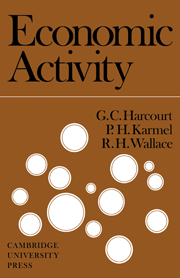Book contents
- Frontmatter
- Preface
- Contents
- 1 INTRODUCTION
- 2 THE NATIONAL ACCOUNTS AND THE INCOME–CREATION PROCESS
- 3 THE PRODUCTION–INCOME–EXPENDITURE CIRCUIT AND NATIONAL ACCOUNTING IDENTITIES
- 4 THE DETERMINATION OF THE EQUILIBRIUM LEVEL OF REAL INCOME
- 5 THE CONCEPT OF FULL EMPLOYMENT
- 6 MONEY IN THE ECONOMIC PROCESS
- 7 THE BANKING SYSTEM AND THE QUANTITY OF MONEY
- 8 THE CONSUMPTION FUNCTION
- 9 THE DETERMINANTS OF INVESTMENT EXPENDITURE
- 10 THE EFFECT OF CHANGES IN EXPENDITURE PLANS: THE MULTIPLIER CONCEPT
- 11 THE GOVERNMENT SECTOR AND THE DETERMINATION OF REAL INCOME
- 12 THE OPEN ECONOMY
- 13 THE INTERACTION BETWEEN PLANNED EXPENDITURES AND FINANCIAL FACTORS
- 14 INFLATION
- 15 ECONOMIC POLICY
- List of suggested reading
- Index
9 - THE DETERMINANTS OF INVESTMENT EXPENDITURE
Published online by Cambridge University Press: 18 December 2009
- Frontmatter
- Preface
- Contents
- 1 INTRODUCTION
- 2 THE NATIONAL ACCOUNTS AND THE INCOME–CREATION PROCESS
- 3 THE PRODUCTION–INCOME–EXPENDITURE CIRCUIT AND NATIONAL ACCOUNTING IDENTITIES
- 4 THE DETERMINATION OF THE EQUILIBRIUM LEVEL OF REAL INCOME
- 5 THE CONCEPT OF FULL EMPLOYMENT
- 6 MONEY IN THE ECONOMIC PROCESS
- 7 THE BANKING SYSTEM AND THE QUANTITY OF MONEY
- 8 THE CONSUMPTION FUNCTION
- 9 THE DETERMINANTS OF INVESTMENT EXPENDITURE
- 10 THE EFFECT OF CHANGES IN EXPENDITURE PLANS: THE MULTIPLIER CONCEPT
- 11 THE GOVERNMENT SECTOR AND THE DETERMINATION OF REAL INCOME
- 12 THE OPEN ECONOMY
- 13 THE INTERACTION BETWEEN PLANNED EXPENDITURES AND FINANCIAL FACTORS
- 14 INFLATION
- 15 ECONOMIC POLICY
- List of suggested reading
- Index
Summary
Introduction
Gross investment expenditure in countries such as Australia has been historically a highly volatile component of aggregate demand. The reasons for this behaviour are discussed in this chapter, which is concerned with the factors that lie behind planned investment expenditure per period.
It is convenient to divide gross capital formation by all sectors into four broad categories, namely, government investment expenditure, investment in housing, gross private fixed investment expenditure, and investment in stocks. Government investment expenditure (Gk) was discussed in chapter 2 where it was described as being determined by the policy decisions of the government.
The analysis of this chapter is concerned with the investment decisions of entities in the market sectors of the economy. For brevity, the analysis is cast in terms of investment in fixed equipment; the argument developed may be applied to the analysis of investment in stocks and investment in housing in so far as it is done by private landlords for rental.
In the Australian economy in the post-war period most of the investment in housing has been done by government agencies, for example, the Victorian Housing Commission and the South Australian Housing Trust, and by owner-occupiers. The decision by an owner-occupier to build can be fitted formally into the analytical framework of the chapter by treating the owner-occupier as matching his estimates of the money value to him of housing services against the relevant costs, in the same manner as do businessmen (see below).
- Type
- Chapter
- Information
- Economic Activity , pp. 140 - 164Publisher: Cambridge University PressPrint publication year: 1967



